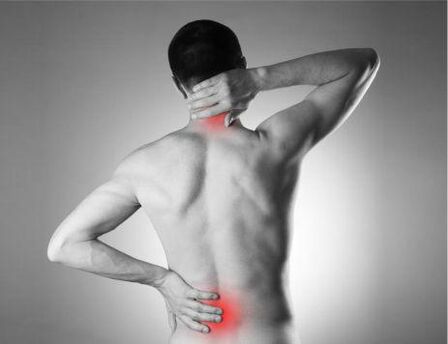With osteochondrosis, the structure and function of the intervertebral discs is compromised, which provides the vertebral column flexibility and mobility.As the disease intensifies, irreversible changes occur in the vertebrae themselves.

The causes of osteochondrosis are internal (endogenous) and external (exogenous).
The endogenous motifs include:
- violation of the intrauterine development of the spine,
- Hereditary predisposition and age -related changes in cartilage.
The main exogenous cause of osteocondrosis is the improper distribution of the load on the spine, which leads to a change in cartilage in the places of excess pressure.
Causes the disease:
- trauma of the spine,
- infections,
- weakened back muscles,
- Side and lateral sidelines of the spine of the spine,
- Drug weights
- A long conservation of an uncomfortable position.
Osteochondrosis can develop not only in people with improper posture engaged in mental work, but also to those who are well trained physically.
In addition to the mechanical reasons for the development of osteocondrosis, they also lead to:
- metabolic disorders (mainly calcium and phosphorus),
- lack of trace elements and vitamins (magnesium, manganese, zinc, vitamin D),
- The hereditary predisposition plays a rather important role.
When they raise weights, jumps, falls, static loads, micro injuries of intervertebral discs.If this systematically happens, the damaged intervertebral discs lose their elastic properties over time, flatten and the distance between the vertebrae decreases.And this means that the nerve roots that extend from the spinal cord are blocked, pain occurs.At the same time, the swelling appears in the clip of the neuro-vascular beam, which leads to an even greater violation and an increase in pain.If the intervertebral disc has already begun to collapse, ceases to cushion, is wounded even more and gradually the spine loses its flexibility.
The main sign of osteocondrosis is pain.Depending on where the damaged intervertebral discs are located, they can hurt: neck, shoulder, arm, back and even a chest.Sometimes a person thinks he has heart problems, but in reality this is a compressed nervousness because of osteochondosis.At the same time as pain, a person often feels overwritten and numb the muscles.If the blood vessels that feed the brain are crushed, headache, dizziness, noise in the ears, double eyes, nausea and vomiting, fainting.
It is necessary to contact these complaints for the neurologist.He will examine the spinal column, will check how things are with brain circulation and, if necessary, will prescribe the radiography, the resonance tomography of computers or magnetic of the corresponding spine.
The treatment of osteochondrosis is a long process that requires a person with great willpower and free time.To date, there are many methods to combat disease: medicine, manual therapy, traction, massage and therapeutic gymnastics.
Suggestions for the prevention of radicalitis and osteochondosis:
- Perform the correction of the curvature of the spine and posture disorders in the early age of the school promptly.
- Actively engaged in physical education, which will allow you to form a muscle corset.
- Adhering to a diet, consuming products with sufficient content of vitamins, calcium and magnesium (fish and other seaside gifts, cabbage, spinach, beans, walnuts, seeds, peas, coarse bread and fresh milk).
- Fight for excess weight.
- When you transfer weights, secure a uniform load on both hands, wear backpacks instead of bags.Lift the weights only with the use of legs, not the spine.



















